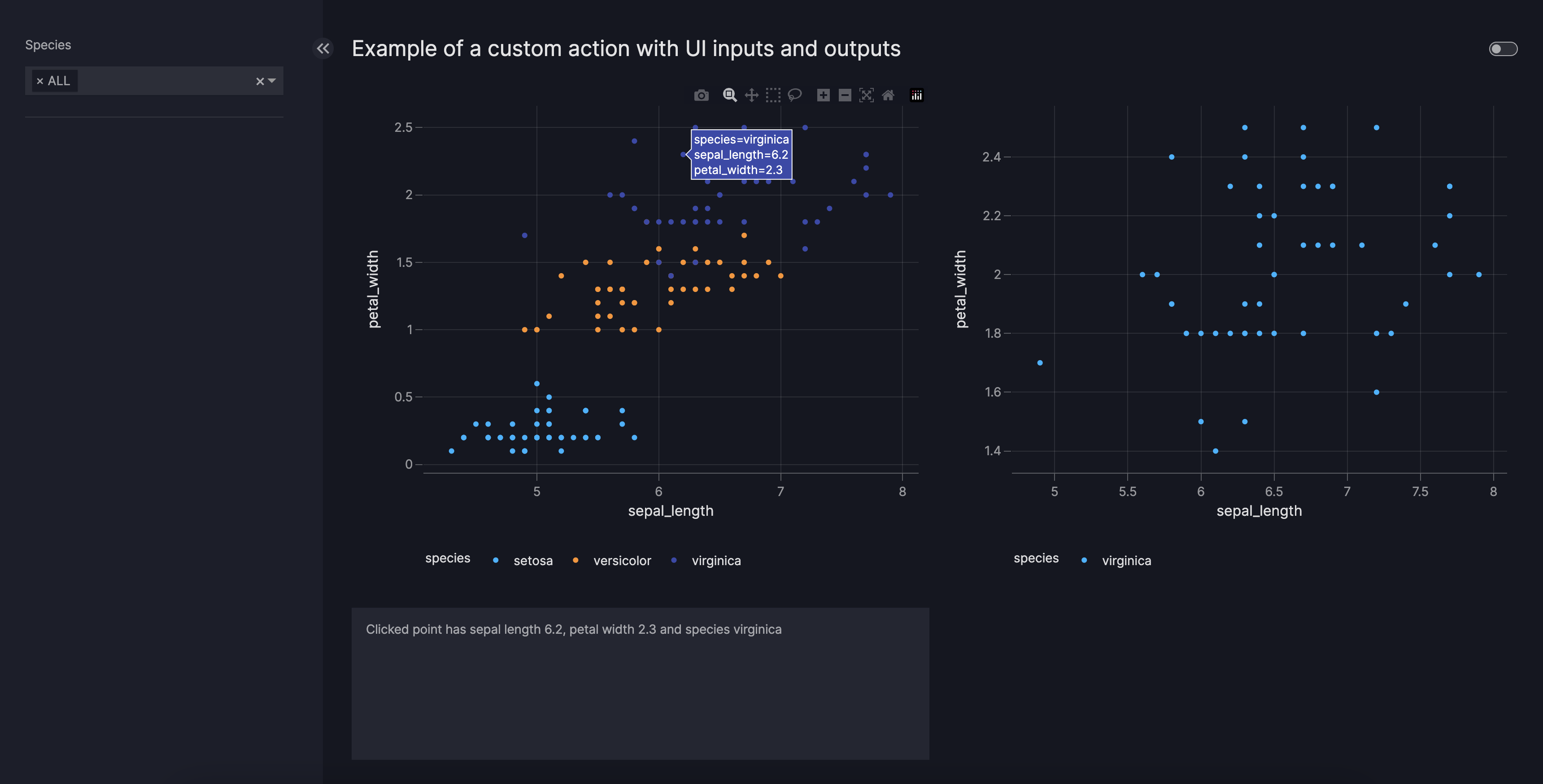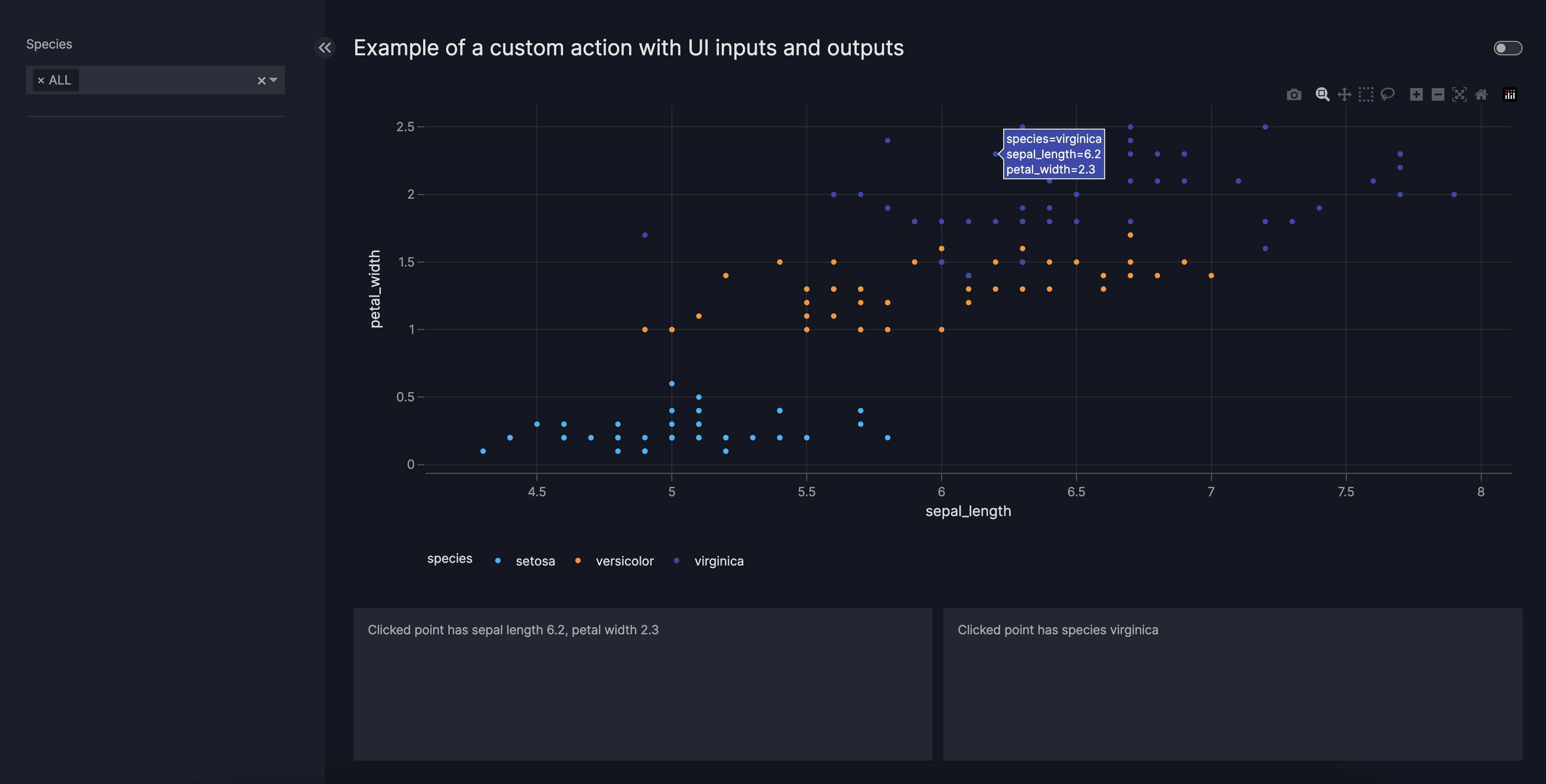How to create custom actions
This guide demonstrates the usage of custom actions, an idea that shares similarities with, but is not identical to callbacks in Dash.
If you want to use the Action model to perform functions that are not available in the pre-defined action functions, you can create your own custom action.
Like other actions, custom actions could also be added as an element inside the actions chain, and it can be triggered with one of many dashboard components.
Simple custom actions
Custom actions enable you to implement your own action function. Simply do the following:
- define a function
- decorate it with the
@capture("action")decorator - add it as a
functionargument inside theActionmodel
The following example shows how to create a custom action that postpones execution of the next action in the chain for t seconds.
Simple custom action
import vizro.models as vm
import vizro.plotly.express as px
from vizro import Vizro
from vizro.actions import export_data
from vizro.models.types import capture
from time import sleep
@capture("action")
def my_custom_action(t: int):
"""Custom action."""
sleep(t)
df = px.data.iris()
page = vm.Page(
title="Example of a simple custom action",
components=[
vm.Graph(
figure=px.scatter(df, x="sepal_length", y="petal_width", color="species")
),
vm.Button(
text="Export data",
actions=[
vm.Action(function=export_data()),
vm.Action(
function=my_custom_action(t=2)
),
vm.Action(function=export_data(file_format="xlsx")),
]
)
],
controls=[vm.Filter(column="species", selector=vm.Dropdown(title="Species"))],
)
dashboard = vm.Dashboard(pages=[page])
Vizro().build(dashboard).run()
Interact with dashboard inputs and outputs
When a custom action needs to interact with the dashboard, it is possible to define inputs and outputs for the custom action.
inputsrepresents dashboard component properties whose values are passed to the custom action function as arguments. It is a list of strings in the format"<component_id>.<property>"(for example,"scatter_chart.clickData").outputsrepresents dashboard component properties corresponding to the custom action function return value(s). Similar toinputs, it is a list of strings in the format"<component_id>.<property>"(for example,"my_card.children").
The following example shows how to create a custom action that shows the clicked chart data in a Card component. For further information on the structure and content of the clickData property, refer to the Dash documentation on interactive visualizations.
Custom action with dashboard inputs and outputs
import vizro.models as vm
import vizro.plotly.express as px
from vizro import Vizro
from vizro.actions import filter_interaction
from vizro.models.types import capture
@capture("action")
def my_custom_action(show_species: bool, points_data: dict): # (1)!
"""Custom action."""
clicked_point = points_data["points"][0]
x, y = clicked_point["x"], clicked_point["y"]
text = f"Clicked point has sepal length {x}, petal width {y}"
if show_species:
species = clicked_point["customdata"][0]
text += f" and species {species}"
return text
df = px.data.iris()
page = vm.Page(
title="Example of a custom action with UI inputs and outputs",
layout=vm.Layout(
grid=[
[0, 2],
[0, 2],
[0, 2],
[1, -1],
],
row_gap="25px",
),
components=[
vm.Graph(
id="scatter_chart",
figure=px.scatter(df, x="sepal_length", y="petal_width", color="species", custom_data=["species"]),
actions=[
vm.Action(function=filter_interaction(targets=["scatter_chart_2"])),
vm.Action(
function=my_custom_action(show_species=True), # (2)!
inputs=["scatter_chart.clickData"], # (3)!
outputs=["my_card.children"],
),
],
),
vm.Card(id="my_card", text="Click on a point on the above graph."),
vm.Graph(
id="scatter_chart_2",
figure=px.scatter(df, x="sepal_length", y="petal_width", color="species"),
),
],
controls=[vm.Filter(column="species", selector=vm.Dropdown(title="Species"))],
)
dashboard = vm.Dashboard(pages=[page])
Vizro().build(dashboard).run()
- Just as for any Python function, the names of the arguments
show_speciesandpoints_dataare arbitrary and do not need to match on to the names ofinputsin any particular way. - We bind (set) the argument
show_speciesto the valueTruein the initial specification of thefunctionfield. These are static values that are fixed when the dashboard is built. - The content of
inputswill "fill in the gaps" by setting values for the remaining unbound arguments inmy_custom_action. Here there is one such argument, namedpoints_data. Values for these are bound dynamically at runtime to reflect the live state of your dashboard.
Multiple return values
The return value of the custom action function is propagated to the dashboard components that are defined in the outputs argument of the Action model.
If there is a single output defined then the function return value is directly assigned to the component property.
If there are multiple outputs defined then the return value is iterated through and each part is assigned to each component property given in outputs in turn. This behavior is identical to Python's flexibility in managing multiple return values.
Custom action with multiple return values
import vizro.models as vm
import vizro.plotly.express as px
from vizro import Vizro
from vizro.models.types import capture
@capture("action")
def my_custom_action(points_data: dict):
"""Custom action."""
clicked_point = points_data["points"][0]
x, y = clicked_point["x"], clicked_point["y"]
species = clicked_point["customdata"][0]
card_1_text = f"Clicked point has sepal length {x}, petal width {y}"
card_2_text = f"Clicked point has species {species}"
return card_1_text, card_2_text # (1)!
df = px.data.iris()
page = vm.Page(
title="Example of a custom action with UI inputs and outputs",
layout=vm.Layout(
grid=[
[0, 0],
[0, 0],
[0, 0],
[1, 2],
],
row_gap="25px",
),
components=[
vm.Graph(
id="scatter_chart",
figure=px.scatter(df, x="sepal_length", y="petal_width", color="species", custom_data=["species"]),
actions=[
vm.Action(
function=my_custom_action(),
inputs=["scatter_chart.clickData"],
outputs=["my_card_1.children", "my_card_2.children"], # (2)!
),
],
),
vm.Card(id="my_card_1", text="Click on a point on the above graph."),
vm.Card(id="my_card_2", text="Click on a point on the above graph."),
],
controls=[vm.Filter(column="species", selector=vm.Dropdown(title="Species"))],
)
dashboard = vm.Dashboard(pages=[page])
Vizro().build(dashboard).run()
my_custom_actionreturns two values (which will be in Python tuple).- These values are assigned to the
outputsin the same order.
Warning
Note that users of this package are responsible for the content of any custom action function that they write - especially with regard to leaking any sensitive information or exposing to any security threat during implementation. You should always treat the content of user input as untrusted.

